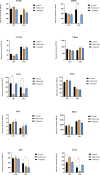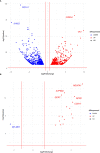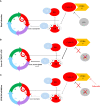In vivo efficacy assessment of the CDK4/6 inhibitor palbociclib and the PLK1 inhibitor volasertib in human chordoma xenografts
- PMID: 36505864
- PMCID: PMC9732546
- DOI: 10.3389/fonc.2022.960720
In vivo efficacy assessment of the CDK4/6 inhibitor palbociclib and the PLK1 inhibitor volasertib in human chordoma xenografts
Abstract
Background: Management of advanced chordomas remains delicate considering their insensitivity to chemotherapy. Homozygous deletion of the regulatory gene CDKN2A has been described as the most frequent genetic alteration in chordomas and may be considered as a potential theranostic marker. Here, we evaluated the tumor efficacy of the CDK4/6 inhibitor palbociclib, as well as the PLK1 inhibitor volasertib, in three chordoma patient-derived xenograft (PDX) models to validate and identify novel therapeutic approaches.
Methods: From our chordoma xenograft panel, we selected three models, two of them harboring a homozygous deletion of CDKN2A/2B genes, and the last one a PBRM1 pathogenic variant (as control). For each model, we tested the palbociclib and volasertib drugs with pharmacodynamic studies together with RT-PCR and RNAseq analyses.
Results: For palbociclib, we observed a significant tumor response for one of two models harboring the deletion of CDKN2A/2B (p = 0.02), and no significant tumor response in the PBRM1-mutated PDX; for volasertib, we did not observe any response in the three tested models. RT-PCR and RNAseq analyses showed a correlation between cell cycle markers and responses to palbociclib; finally, RNAseq analyses showed a natural enrichment of the oxidative phosphorylation genes (OxPhos) in the palbociclib-resistant PDX (p = 0.02).
Conclusion: CDK4/6 inhibition appears as a promising strategy to manage advanced chordomas harboring a loss of CDKN2A/2B. However, further preclinical studies are strongly requested to confirm it and to understand acquired or de novo resistance to palbociclib, in the peculiar view of a targeting of the oxidative phosphorylation genes.
Keywords: CDK4/6 inhibitor; CDKN2A/2B deletion; PLK1 inhibitor; chordoma patient’s derived xenograft; palbocicib; volasertib.
Copyright © 2022 Passeri, Dahmani, Masliah-Planchon, El Botty, Courtois, Vacher, Marangoni, Nemati, Roman-Roman, Adle-Biassette, Mammar, Froelich, Bièche and Decaudin.
Conflict of interest statement
The authors declare that the research was conducted in the absence of any commercial or financial relationships that could be construed as a potential conflict of interest.
Figures






Similar articles
-
Dramatic In Vivo Efficacy of the EZH2-Inhibitor Tazemetostat in PBRM1-Mutated Human Chordoma Xenograft.Cancers (Basel). 2022 Mar 14;14(6):1486. doi: 10.3390/cancers14061486. Cancers (Basel). 2022. PMID: 35326637 Free PMC article.
-
Integrated genomic analyses in PDX model reveal a cyclin-dependent kinase inhibitor Palbociclib as a novel candidate drug for nasopharyngeal carcinoma.J Exp Clin Cancer Res. 2018 Sep 20;37(1):233. doi: 10.1186/s13046-018-0873-5. J Exp Clin Cancer Res. 2018. PMID: 30236142 Free PMC article.
-
Cyclin dependent kinase 4/6 inhibitor palbociclib synergizes with BCL2 inhibitor venetoclax in experimental models of mantle cell lymphoma without RB1 deletion.Exp Hematol Oncol. 2024 Mar 25;13(1):34. doi: 10.1186/s40164-024-00499-2. Exp Hematol Oncol. 2024. PMID: 38528594 Free PMC article.
-
Spotlight on Volasertib: Preclinical and Clinical Evaluation of a Promising Plk1 Inhibitor.Med Res Rev. 2016 Jul;36(4):749-86. doi: 10.1002/med.21392. Epub 2016 May 3. Med Res Rev. 2016. PMID: 27140825 Review.
-
Review: Precise sarcoma patient-derived orthotopic xenograft (PDOX) mouse models enable identification of novel effective combination therapies with the cyclin-dependent kinase inhibitor palbociclib: A strategy for clinical application.Front Oncol. 2022 Aug 8;12:957844. doi: 10.3389/fonc.2022.957844. eCollection 2022. Front Oncol. 2022. PMID: 36003796 Free PMC article. Review.
Cited by
-
Integrated Molecular and Histological Insights for Targeted Therapies in Mesenchymal Sinonasal Tract Tumors.Curr Oncol Rep. 2024 Mar;26(3):272-291. doi: 10.1007/s11912-024-01506-9. Epub 2024 Feb 20. Curr Oncol Rep. 2024. PMID: 38376625 Free PMC article. Review.
-
Evaluation of Combined Chemotherapy and Genomic-Driven Targeted Therapy in Patient-Derived Xenografts Identifies New Therapeutic Approaches in Squamous Non-Small-Cell Lung Cancer Patients.Cancers (Basel). 2024 Aug 7;16(16):2785. doi: 10.3390/cancers16162785. Cancers (Basel). 2024. PMID: 39199558 Free PMC article.
-
Mutational analysis of primary and advanced chordoma tissue using next-generation sequencing.Cancer. 2025 Aug 15;131(16):e70033. doi: 10.1002/cncr.70033. Cancer. 2025. PMID: 40802536 Free PMC article.
-
A retrospective study on the mechanism underlying quick transfer from response to resistance in a repeated recurrent chordoma patient with molecular alterations treated with Palbociclib.J Cancer Res Clin Oncol. 2024 Feb 19;150(2):95. doi: 10.1007/s00432-023-05560-x. J Cancer Res Clin Oncol. 2024. PMID: 38369555 Free PMC article.
-
An imbalance between proliferation and differentiation underlies the development of microRNA-defective pineoblastoma.Genes Dev. 2025 Jun 2;39(11-12):727-750. doi: 10.1101/gad.352485.124. Genes Dev. 2025. PMID: 40240142
References
LinkOut - more resources
Full Text Sources
Molecular Biology Databases
Miscellaneous

